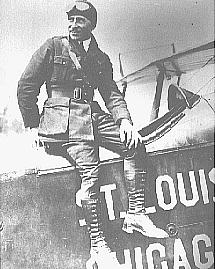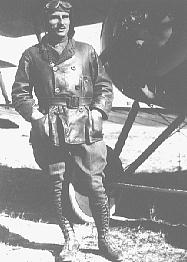
|
|
|
The Last Air Mail Pioneer Pilot By Nancy Allison Wright
At the age of 103 E. Hamilton "Ham" Lee (shown right and below in his younger days) was the sole surviving pilot of the U. S . Post Office Air Mail Service, 1918-1927. He was also one of the last members of Early Birds of Aviation. Lee alone among the 30 members of the Air Mail Pioneers (AMP), a last-man club composed of Service employees, battled snow, rain and the gloom of night along the U. S. transcontinental route to bring the mail through. In Curtiss Jennies and DeHavilland-4s, Lee, and his fellow pioneer pilots, risked their lives to establish world's first scheduled air transport system. "At the start," said Lee, "we had no radios, no parachutes and few instruments. We flew mostly by landmarks - when we could see them. In a fog or thick clouds, we just flew by the seat of our pants." By the time the Post Office Air Mail Service launched its inaugural flight, on May 15, 1918, Lee had been flying for over two years. In l913 Lee made his first flight, riding on the wing of a Curtiss Pusher, clutching the struts and looking over his instructor's shoulder. Three years later, after accumulating five hours in the air, he soloed. His pilot's license was signed by Orville Wright. At first Lee made a living barnstorming at county fairs: selling rides and performing aerobatics. Then in 1917 when the United States declared war on Germany, he became a civilian instructor with the U. S. Army Signal Corps, the Air Force's predecessor. After the war ended, Lee learned that the new U.S. Post Office Air Mail Service was recruiting civilian pilots for air mail duty. Prior to this, during the three months the Post Office and War Department shared the operation, the mail had been flown by Army fly boys. Lee began his career in the Service on December 29, 1918. Among the many aviation milestones credited to Lee during his time in the Service is his participation in the country's first pilots' strike. To prove to Congress that air mail was reliable, Post Office officials insisted that the mail be flown in all kinds of weather. Consequently, Lee and other air mail pilots took off in fog so soupy they couldn't see their wing tips or across their air fields' cinder runways. They flew into the blackness of thunder storms that batted their fragile craft like a leaf. In July 1919 on a rainy, cloudy morning with visibility 200 feet and worsening, pilot Leon Smith refused to fly the New York to Washington run until the weather lifted. Assistant Postmaster General Otto Praeger, who had never flown a plane, responded with the order to "fly by compass, visibility not necessary." Smith again refused and so did Lee when he was asked to replace him. Both men were fired on the spot. In sympathy all the pilots in the system went on strike. Three days later pilots and management reached a compromise settlement. In times of marginal weather the field manager would go aloft and check conditions himself. If he returned safely the flight would take place. If the field manager was not a pilot, he could sit in the mail bin right behind the engine while the pilot circled the field, checking the weather. Under those circumstances Lee agreed to return and was rehired. Still accidents were frequent. Accidents killed 31 of the first 40 pilots hired in the first two years of operation. The life expectancy of early Air Mail pilots was estimated to be three years. Although Lee was one of the oldest and most conservative of the mail pilots, he was not immune to misjudging flying weather. In March 1924 Lee ran into snow storms taking off from Iowa City bound for Chicago and had to land three times to wait for conditions to improve. Departing a field near Rock Falls, he flew straight into a "blind black blizzard." Attempting to land he went through a fence and hit a tree stump, causing the DH to flip on its back. Lee walked away from the accident with only a few bumps and bruises.
Another time the engine of Lee's plane caught fire. To loose altitude fast, he side slipped. "It kept the flames away from my face and allowed the air stream to blow out the fire," he said. "It was touch and go but I continued the flight." When the Air Mail Service pioneered the transcontinental route between New York and San Francisco, Lee was on hand to blaze the first air trails. In 1920 he inaugurated two feeder routes: the Chicago to St. Louis run and the Minneapolis to Chicago leg. When the Service experimented with night flying on the transcontinental in 1924, Lee flew one of the two first legs out of Hazelhurst Field on Long Island. In all Lee spent 4,220 hours aloft in the service of the Air Mail and covered 382,426 miles. But that was only for openers. After private industry took over the Air Mail Service in 1927, Lee flew for Boeing Air Transport, then remained when BAT merged with other early lines to form United Airlines. By the time he retired from United, Lee had flown 4.4 million miles and logged a record 27,812 hours of flight time. He had been the first person to travel a million miles off the ground. Ham celebrated his 100th birthday by co-piloting a DC-3 on a 30-minute trip from Ontario to Van Nuys, California. "I just love flying," said Lee. "I always have." Nancy Allison Wright is editor of the Air Mail Pioneers News, a periodic newsletter of Air Mail Pioneers. Her father, Ernest M. "Allie" Allison, was former national treasurer and western division president of Air Mail Pioneers. |
History |
Air Mail Pilots
|
Photo
Gallery |
Flight Info
|
Antique Airplanes
|
Members |
|
copyright © 1999 Nancy Allison Wright, President Air Mail Pioneers
|

